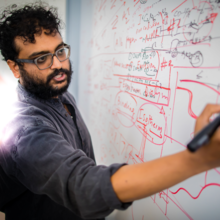
Getty Images
Could COVID-19 Help Refine AI, Data Analytics in Healthcare?
In the rush to contain COVID-19, leaders are rapidly developing artificial intelligence and data analytics in healthcare, paving the way for the future of the technologies.
In the months since COVID-19 has evolved from a blip on the world’s radar to a full-blown global health crisis, the virus has managed to shine a glaring light on some of healthcare’s most foundational cracks.
Gaps in care, disparate IT systems, and clinician burnout have become all the more visible in the midst of confusion and uncertainty, and stakeholders have realized that their response efforts may have to go beyond the current pandemic.
As the US continues to monitor the spread of coronavirus and the country starts to think about relaxing social distancing measures, healthcare leaders are examining their abilities to mitigate the impact of this outbreak now and going forward.
For many organizations, this will mean implementing or enhancing artificial intelligence and data analytics in healthcare.
AI and data analytics have featured largely in the healthcare industry’s line of defense against COVID-19. Researchers have leveraged these tools to do everything from tracking hospital capacity to identifying high-risk patients, and many believe that these technologies are critical to preparing for similar situations in the future.
“Machine learning and data analytics are going to play a really important role in understanding the spread of disease, as well as understanding the effectiveness of our different responses to disease,” Joe Corkery, MD, director of product management at Google Cloud, told HealthITAnalytics.
“We're going to see a lot of impact there. We're seeing drug discovery at scale, and the effect of data analytics in real time. This kind of research is highlighting the fact that there are a lot of new things that we can do to make data analytics more easily repeatable and specific to healthcare use cases.”
While coronavirus has accentuated the promise of advanced analytics tools, the pandemic has also revealed the relative immaturity of the technology. Issues around data access, sharing, and quality still impact the accuracy of algorithms, as well as the ability to develop algorithms in the first place. For an industry that has spent years with the EHR and digital data, one has to wonder: Why is so much of healthcare still reactive instead of proactive?
With COVID-19 disrupting the standard state of affairs, the stage is set for major industry players to come together and improve their data analytics capabilities. Experts and leaders from all sectors are working to overcome healthcare’s long-standing data challenges, preparing the way for artificial intelligence to take on a larger role in patient care.
A heightened emphasis on gathering and accessing quality data
Although the need for quality, timely data is always a priority in healthcare, the ever-changing coronavirus outbreak has made data accuracy even more necessary.
“Everything about COVID-19 is still in the early stages. There's so much new data coming in and so much information evolving,” said Corkery. “A great deal of research is required to understand how we can best address the disease and use technology to improve our response, as well as help develop future therapeutics.”
To ensure information is quality and up-to-date, many in the industry have sought to collect real-world data during the pandemic. This information, collected from sources other than traditional clinical trials, can help stakeholders identify patterns and make critical decisions.
At Regenstrief Institute, researchers are leveraging the power of real-world data to better understand COVID-19. The organization recently announced that they would be conducting an anonymous, national survey to fill gaps in knowledge about the virus.

“As we begin to open up the economy and relax social distancing measures, we need to have a better sense of the underlying prevalence of the virus, because we think that many people who have this disease are asymptomatic or have very mild symptoms,” said Brian Dixon, PhD, director of public health informatics at Regenstrief Institute.
With the healthcare system encouraging people to stay home if they can manage their illness on their own, the only way to know who has symptoms is to survey the population, Dixon said. The project allows people to report on their symptoms from their mobile device or web browser, providing researchers with a comprehensive picture of disease trends and hotspots.
“What we're hoping to do is capture enough data from different geographic locations so that we can start to see patterns in symptoms. If we can see the clusters of symptoms going down over time, then we know that people are adhering to social distancing measures, and we can start to move forward with reopening the economy,” Dixon explained.
In conducting the survey, the Regenstrief team is seeking to find new, viable ways of collecting data that can be used in the future.
“One of our goals for this study is to see how effective we can be at capturing this kind of data from the general population when everyone is dispersed, and people have to start working from home,” Dixon said.
“In the long term, this survey can tell us whether these direct data collection methods can be useful in a situation like a pandemic or disease outbreak.”
In addition to real-world data, researchers have increasingly turned to open, publicly available datasets to ensure they’re accessing quality COVID-19 information. Using these datasets, teams can develop artificial intelligence and data analytics algorithms to better understand the virus and its impact.

“This is the way we're going to do this type of research in the future,” said Michael Dennis, vice president of innovation of CAS, a division of the American Chemical Society.
“In the past, some software systems and algorithms may have fallen short because they didn't have the refined content that they needed to find actionable insights or drive informed decision-making. The algorithms are the algorithms, but having that quality underlying data is what makes them work.”
CAS recently released an open-access dataset of chemical compounds with known or potential antiviral activity to support research, analytics, and machine learning applications. The dataset supports the White House’s recent call to action for experts to develop AI solutions in response to COVID-19.
The data resource is the first chemical substance collection contributed to the COVID-19 Open Research Dataset (CORD-19) and could help inform the development of a COVID-19 vaccine.
“Going forward, there will be a much greater emphasis on quality information and quality data. Because that will accelerate research not just in the drug discovery space, but in other spaces, too. And COVID-19 is going to prove that in spades,” he said.
Novel collaborations, increased data sharing
As the healthcare industry formed its defense against coronavirus, a noticeable pattern began to emerge: Organizations from different sectors and individuals in different parts of the world started to work together to find solutions.
The unanticipated nature of the outbreak, coupled with the need to better understand COVID-19, united all segments under a common goal.
“What we are seeing are unprecedented collaborations,” said Haribabu Arthanari, PhD, assistant professor at Harvard Medical School and Dana Farber Cancer Institute. “This situation has opened up doors that we would have never thought to knock on.”
Harvard Medical School and Dana Farber Cancer Institute recently partnered with Google Cloud to leverage advanced cloud and analytics technologies to accelerate the discovery of potential therapies.
Using an open-source virtual drug discovery platform, the researchers are able to target billions of drug compounds against COVID-19 proteins in a matter of days, drastically reducing the time it takes to analyze possible treatments.
“This partnership is helping us get to the finish line in a much shorter amount of time, which we would have never imagined,” Arthanari said. “We couldn’t have done this in the limited time that we have to rapidly respond to this crisis.”
The partnership is part of a wider effort by Google to support academic researchers and the communities they serve. In addition to Harvard, the tech giant is collaborating with Northeastern University and the University of Virginia to track and forecast the spread of COVID-19.
Google has also offered researchers free access to critical coronavirus information in order to further accelerate analytics solutions.

“To help with these projects, we've expanded the coverage of our public data set program and launched a COVID-19-specific public data set program, so that people can query these datasets themselves and join them with other data,” Corkery said.
“We're really excited to be able to partner with the different organizations that are coming through this program, and to help them understand how we can work together to improve analytics and models that they can apply to the industry.”
Partnerships like the one between Harvard Medical School and Google Cloud just might be the key to uncovering a vaccine, Dennis noted.
“There is absolutely going to be a treatment. It's not a question of if, but when. And that treatment will most likely come from collaborations between drug discovery researchers and experts in data analytics and AI,” he said.
“Of those organizations that are downloading the CAS dataset, many are the traditional pharma, biotech researchers. But we’ve also seen that a lot of people whose focus is more on algorithms and data mining are downloading the dataset. They want to be able to take all of that data and find the needle in the haystack.”
These co-disciplinary efforts are leading to more comprehensive research, and more comprehensive results.
“Through these collaborations, we're filling in the gaps. People are bringing data, they're bringing data scientists, and they're bringing medicinal chemists. We're seeing a sharing of knowledge and information like never before,” Dennis said.
Cross-sector partnerships have not only accelerated research; they have also shed light on some of the major technological gaps in the healthcare industry, Dixon stated.
“Over the last ten to 15 years, health systems and large providers have been moving their data systems and assets into the cloud, so healthcare executives have become more comfortable with analytics and analytical platforms,” he said.
“This pandemic has shown that policymakers – public health departments in particular – who are coordinating response efforts want to have access to information, but their infrastructure is not at the same level that it is in health systems.”
More seamless data exchange between these two segments will help inform decision-making and improve data analysis.
“One of the lasting effects of this pandemic is the understanding that connectivity needs to be in place, and that the infrastructure in public health is just as important as it is in healthcare systems. There needs to be the ability to not only rapidly collect data, but then analyze that data and move it around to the parties that need it,” said Dixon.
Envisioning the healthcare industry in a post-COVID-19 world
Even when the dust has settled and the pandemic is over – whenever that may be – there is a vague notion that the status quo won’t be exactly what the world once knew. The changes may be small, almost imperceptible, but they will still be there.
In healthcare, these changes may be more evident.
New ways of collecting, sharing, and evaluating data will hopefully extend into life after COVID-19, leading to new technological advancements that have previously eluded the industry.
With better data, increased collaboration, and faster analysis, researchers could transform patient care and prepare for any future emergencies.
“I believe in the old adage that necessity becomes the mother of invention. This pandemic has been a catalyst for transformation,” said Arthanari.

“We did not know how to face this crisis, but the tools that we're developing could be very helpful for future drug discoveries, future pandemics, or other diseases that don’t generate much pharmaceutical interest because they don’t impact people in developed countries.”
The combined efforts from stakeholders across the healthcare industry will facilitate more opportunities for researchers in all areas.
“I don’t think this collaboration will end with COVID-related research. The platform we’ve developed is an open-source platform, so it’s available to everybody,” said Arthanari.
“This platform democratizes something that before, only a few big pharmaceutical companies and Ivy League institutions could do. But now with this model, and what we will develop in the future, anybody can use it for whatever target they want. These partnerships could drastically reduce the time that one needs to get to a drug into the market.”
The outbreak could also revolutionize the process of vaccine development, Dennis added.
“This will transform the way we're discovering drugs going forward. This isn't a one and done. We're going to see more of these types of partnerships and this type of research,” he said.
These positive changes will likely spill over into the public health realm as well, with processes and initiatives established during the pandemic continuing on into the future.
“We will continue to see an emphasis on connecting healthcare systems and healthcare providers with each other and with public health. With this pandemic, we've seen a lot of providers wanting to participate in health information exchange organizations to access coronavirus data rapidly. We’ve seen HIE organizations step up and make this data available to public health authorities,” said Dixon.
For Dixon, this brings up a lot of questions.
“It makes us ask, why weren’t we doing this before? And after this pandemic, how can we continue to do this? How can we continue to work together and invest in these infrastructures so that we can collect data, share that data, and analyze that data rapidly in pandemic situations? Or even in smaller-scale situations, like a localized outbreak of food poisoning or salmonella?”
An event as massive as a global health crisis will inevitably bring change, especially if the systems needed changing in the first place. The COVID-19 pandemic has shed light on some of healthcare’s most pressing challenges, and the industry’s response could improve the way things are done going forward.
“If there's any silver lining of COVID-19, that's one of them – that organizations that might have been competitors are now partnering for the good of the world. And I think we're going to continue to see that in the future,” said Dennis.







